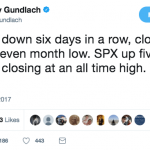Towards the end of economic expansions, interest rates usually start to rise as strong loan demand bumps up against central bank tightening.
At first, the effect on the broader economy is minimal, so consumers, companies, and governments don’t let a slight uptick in financing costs interfere with their borrowing and spending. But eventually rising rates begin to bite and borrowers get skittish, throwing the leverage machine into reverse and producing an equities bear market and Main Street recession.
We are there. After a year of gradual increases, interest rates are finally high enough to start popping bubbles. Consider housing and autos:
Mortgage Rates Up, Affordability Down, Housing Party Over
The past few years’ housing boom has been relatively quiet, but a boom nonetheless. Mortgage rates in the 3% – 4% range made houses widely affordable, so demand exceeded supply and prices rose, eventually surpassing 2006 bubble levels in hot markets like Denver and Seattle.
But this week mortgages hit 5% …
… and people have begun to notice. Here’s an example of the resulting media coverage:
Mortgage rates top 5 percent, signaling more home price cuts
Some of us out there still remember when the average rate on the 30-year fixed mortgage hit 9 percent, but we are not the bulk of today’s buyers. Millennials, now in their prime homebuying years, may be in for the rude awakening that credit isn’t always cheap.
The average rate on the 30-year fixed loan sat just below 4 percent a year ago, after dropping below 3.5 percent in 2016. It just crossed the 5 percent mark, according to Mortgage News Daily. That is the first time in 8 years, and it is poised to move higher. Five percent may still be historically cheap, but higher rates, combined with other challenges facing today’s housing market could cause potential buyers to pull back.
“Five percent is definitely an emotional level inasmuch as it scares prospective buyers about how high rates may continue to go,” said Matthew Graham, chief operating officer of MND.
Home sales have been sliding for much of this year, and total annual sales are expected to come in lower than last year. Affordability is the clear culprit. With rates now more than a full percentage point higher than a year ago, that adds at least $200 more to a monthly mortgage payment for a $300,000 loan. It also knocks some borrowers out of qualification because lenders are strict on how much debt a borrower can carry in relation to his or her income.







Leave A Comment